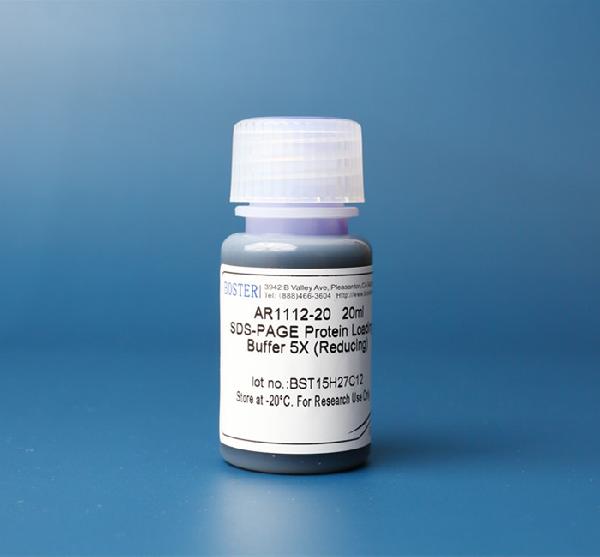Product Info Summary
| SKU: | M00250 |
|---|---|
| Size: | 100ug |
| Reactive Species: | Bovine, Guinea pig, Hamster, Human, Monkey, Mouse, Rabbit, Rat |
| Host: | Rat |
| Application: | ELISA, IP, IF, IHC, ICC, WB, Gel Shift |
Customers Who Bought This Also Bought
Product info
Product Name
Anti-HSF1 Monoclonal Antibody
SKU/Catalog Number
M00250
Size
100ug
Form
liquid
Description
Boster Bio Anti-HSF1 Monoclonal Antibody catalog # M00250. Tested in ELISA, IP, IF, IHC, WB applications. This antibody reacts with Human, Mouse, Rat.
Storage & Handling
Store at -20°C for one year. Avoid repeated freeze-thaw cycles.
Cite This Product
Anti-HSF1 Monoclonal Antibody (Boster Biological Technology, Pleasanton CA, USA, Catalog # M00250)
Host
Rat
Contents
PBS pH7.4, 50% glycerol, 0.09% sodium azide
Clonality
Monoclonal
Clone Number
10H8
Isotype
IgG1
Immunogen
Purified recombinant mouse HSF1 protein, with epitope mapping to amino acids 378-395
*Blocking peptide can be purchased. Costs vary based on immunogen length. Contact us for pricing.
Cross-reactivity
Detects ~85kDa (unstressed cell lysates), and~95kDa (heat shocked cell lysates).
Reactive Species
M00250 is reactive to HSF1 in Bovine, Guinea pig, Hamster, Human, Monkey, Mouse, Rabbit, Rat
Reconstitution
Calculated molecular weight
57.26kDa
Background of HSF1
HSF1, or heat shock factor 1, belongs to a family of Heat Shock transcription factors that activate the transcription of genes encoding products required for protein folding, processing, targeting, degradation, and function (2). The up-regulation of HSP (heat shock proteins) expression by stressors is achieved at the level of transcription through a heat shock element (HSE) and a transcription factor (HSF) (3, 4, 5). Most HSFs have highly conserved amino acid sequences. On all HSFs there is a DNA binding domain at the N-terminus. Hydrophobic repeats located adjacent to this binding domain are essential for the formation of active trimers. Towards the C-terminal region another short hydrophobic repeat exists, and is thought to be necessary for suppression of trimerization (6). There are two main heat shock factors, 1 and 2. Mouse HSF1 exists as two isoforms, however in higher eukaryotes HSF1 is found in a diffuse cytoplasmic and nuclear distribution in un-stressed cells. Once exposed to a multitude of stressors, it localizes to discrete nuclear granules within seconds. As it recovers from stress, HSF1 dissipates from these granules to a diffuse nuceloplasmic distribution. HSF2 on the other hand is similar to mouse HSF1, as it exists as two isoforms, the alpha form being more transcriptionally active than the smaller beta form (7, 8). Various experiments have suggested that HFS2 may have roles in differentiation and development (9, 10, 11).
Antibody Validation
Boster validates all antibodies on WB, IHC, ICC, Immunofluorescence, and ELISA with known positive control and negative samples to ensure specificity and high affinity, including thorough antibody incubations.
Application & Images
Applications
M00250 is guaranteed for ELISA, IP, IF, IHC, ICC, WB, Gel Shift Boster Guarantee
Assay Dilutions Recommendation
The recommendations below provide a starting point for assay optimization. The actual working concentration varies and should be decided by the user.
WB (1:1000), IHC (1:1000), ICC/IF (1:200); optimal dilutions for assays should be determined by the user.
Validation Images & Assay Conditions

Click image to see more details
Immunocytochemistry/Immunofluorescence analysis using Rat Anti-HSF1 Monoclonal Antibody, Clone 10H8 (M00250) . Tissue: Heat Shocked HeLa Cells. Species: Human. Fixation: 2% Formaldehyde for 20 min at RT. Primary Antibody: Rat Anti-HSF1 Monoclonal Antibody (M00250) at 1:100 for 12 hours at 4°C. Secondary Antibody: APC Goat Anti-Rat (red) at 1:200 for 2 hours at RT. Counterstain: DAPI (blue) nuclear stain at 1:40000 for 2 hours at RT. Localization: Diffuse nuclear and cytoplasmic staining. Magnification: 20x. (A) DAPI (blue) nuclear stain. (B) Anti-HSF1 Antibody. (C) Composite. Heat Shocked at 42°C for 1h.

Click image to see more details
Immunocytochemistry/Immunofluorescence analysis using Rat Anti-HSF1 Monoclonal Antibody, Clone 10H8 (M00250) . Tissue: Heat Shocked mitotic HeLa cells. Species: Human. Primary Antibody: Rat Anti-HSF1 Monoclonal Antibody (M00250) at 1:1000. HSF1 stained green. Courtesy of: Morimoto Lab, Northwestern University, USA.

Click image to see more details
Immunocytochemistry/Immunofluorescence analysis using Rat Anti-HSF1 Monoclonal Antibody, Clone 10H8 (M00250) . Tissue: Heat Shocked HeLa Cells. Species: Human. Fixation: 2% Formaldehyde for 20 min at RT. Primary Antibody: Rat Anti-HSF1 Monoclonal Antibody (M00250) at 1:100 for 12 hours at 4°C. Secondary Antibody: FITC Goat Anti-Rat (green) at 1:200 for 2 hours at RT. Counterstain: DAPI (blue) nuclear stain at 1:40000 for 2 hours at RT. Localization: Diffuse nuclear and cytoplasmic staining. Magnification: 100x. (A) DAPI (blue) nuclear stain. (B) Anti-HSF1 Antibody. (C) Composite. Heat Shocked at 42°C for 1h.

Click image to see more details
Immunohistochemistry analysis using Rat Anti-HSF1 Monoclonal Antibody, Clone 10H8 (M00250). Tissue: Breast carcinoma. Species: Human. Fixation: 10% Formalin Solution for 20 hours at RT. Primary Antibody: Rat Anti-HSF1 Monoclonal Antibody (M00250) at 1:1000 for 40 min. Secondary Antibody: Dako labeled Polymer HRP Anti-rat IgG, DAB Chromogen (brown) (Dako Envision+ System) for 30 min at RT. Counterstain: Mayer’s Hematoxylin (purple/blue) nuclear stain for 1 minute at RT. Localization: Nuclear. Magnification: 100X. Courtesy of: Dr. Sandro Santagata, Harvard Medical School.

Click image to see more details
Western Blot analysis of Human Breast adenocarcinoma cell line (MCF7) showing detection of ~65 kDa HSF1 protein using Rat Anti-HSF1 Monoclonal Antibody, Clone 10H8 (M00250). Lane 1: MW ladder. Lane 2: HSF1 null lysate prepared from mouse embryonic fibroblasts. Lane 3: MCF7 lysate (5 µg). Lane 4: MCF7 lysate (10 µg). Lane 5: MCF7 lysate (20 µg). Block: 1.5% BSA for 30 minutes at RT. Primary Antibody: Rat Anti-HSF1 Monoclonal Antibody (M00250) at 1:1000 for 2 hours at RT. Secondary Antibody: Goat Anti-Rat IgG: HRP for 1 hour at RT. Predicted/Observed Size: ~65 kDa. Courtesy of: Dr. Sandro Santagata, Harvard Medical School.
Protein Target Info & Infographic
Gene/Protein Information For HSF1 (Source: Uniprot.org, NCBI)
Gene Name
HSF1
Full Name
Heat shock factor protein 1
Weight
57.26kDa
Superfamily
HSF family
Alternative Names
HSTF1, Heat shock factor protein 1, Heat shock transcription factor 1, HSF 1 HSF1 HSTF1 heat shock transcription factor 1 heat shock factor protein 1
*If product is indicated to react with multiple species, protein info is based on the gene entry specified above in "Species".For more info on HSF1, check out the HSF1 Infographic

We have 30,000+ of these available, one for each gene! Check them out.
In this infographic, you will see the following information for HSF1: database IDs, superfamily, protein function, synonyms, molecular weight, chromosomal locations, tissues of expression, subcellular locations, post-translational modifications, and related diseases, research areas & pathways. If you want to see more information included, or would like to contribute to it and be acknowledged, please contact [email protected].
Specific Publications For Anti-HSF1 Monoclonal Antibody (M00250)
Hello CJ!
M00250 has been cited in 1 publications:
*The publications in this section are manually curated by our staff scientists. They may differ from Bioz's machine gathered results. Both are accurate. If you find a publication citing this product but is missing from this list, please let us know we will issue you a thank-you coupon.
Higher heat shock factor 1 expression in tumor stroma predicts poor prognosis in esophageal squamous cell carcinoma patients
Recommended Resources
Here are featured tools and databases that you might find useful.
- Boster's Pathways Library
- Protein Databases
- Bioscience Research Protocol Resources
- Data Processing & Analysis Software
- Photo Editing Software
- Scientific Literature Resources
- Research Paper Management Tools
- Molecular Biology Software
- Primer Design Tools
- Bioinformatics Tools
- Phylogenetic Tree Analysis
Customer Reviews
Have you used Anti-HSF1 Monoclonal Antibody?
Submit a review and receive an Amazon gift card.
- $30 for a review with an image
0 Reviews For Anti-HSF1 Monoclonal Antibody
Customer Q&As
Have a question?
Find answers in Q&As, reviews.
Can't find your answer?
Submit your question
5 Customer Q&As for Anti-HSF1 Monoclonal Antibody
Question
My question regards using your anti-HSF1 Monoclonal antibody for r-mmu-3371453; regulation of hsf1-mediated heat shock response studies. Has this antibody been tested with western blotting on hela cells? We would like to see some validation images before ordering.
Verified Customer
Verified customer
Asked: 2020-02-05
Answer
Thank you for your inquiry. This M00250 anti-HSF1 Monoclonal antibody is tested on hela cells, mitotic hela cells. It is guaranteed to work for ELISA, IP, IF, IHC, WB in human, mouse, rat. Our Boster guarantee will cover your intended experiment even if the sample type has not been be directly tested.
Boster Scientific Support
Answered: 2020-02-05
Question
We are currently using anti-HSF1 Monoclonal antibody M00250 for human tissue, and we are well pleased with the WB results. The species of reactivity given in the datasheet says human, mouse, rat. Is it possible that the antibody can work on feline tissues as well?
Verified Customer
Verified customer
Asked: 2019-09-25
Answer
The anti-HSF1 Monoclonal antibody (M00250) has not been validated for cross reactivity specifically with feline tissues, though there is a good chance of cross reactivity. We have an innovator award program that if you test this antibody and show it works in feline you can get your next antibody for free. Please contact me if I can help you with anything.
Boster Scientific Support
Answered: 2019-09-25
Question
We bought anti-HSF1 Monoclonal antibody for IP on muscle a few months ago. I am using mouse, and We intend to use the antibody for IF next. We want examining muscle as well as leukemic t-cell in our next experiment. Could you please give me some suggestion on which antibody would work the best for IF?
Verified Customer
Verified customer
Asked: 2019-02-27
Answer
I looked at the website and datasheets of our anti-HSF1 Monoclonal antibody and I see that M00250 has been tested on mouse in both IP and IF. Thus M00250 should work for your application. Our Boster satisfaction guarantee will cover this product for IF in mouse even if the specific tissue type has not been validated. We do have a comprehensive range of products for IF detection and you can check out our website bosterbio.com to find out more information about them.
Boster Scientific Support
Answered: 2019-02-27
Question
Our lab were satisfied with the WB result of your anti-HSF1 Monoclonal antibody. However we have seen positive staining in cervix carcinoma erythroleukemia nucleus using this antibody. Is that expected? Could you tell me where is HSF1 supposed to be expressed?
Verified Customer
Verified customer
Asked: 2018-05-01
Answer
From literature, cervix carcinoma erythroleukemia does express HSF1. Generally HSF1 expresses in nucleus. Regarding which tissues have HSF1 expression, here are a few articles citing expression in various tissues:
Cervix carcinoma, Pubmed ID: 17081983, 18220336, 18669648, 20068231
Cervix carcinoma, and Erythroleukemia, Pubmed ID: 23186163
Leukemic T-cell, Pubmed ID: 19690332
Liver, Pubmed ID: 24275569
Muscle, Pubmed ID: 15489334
Boster Scientific Support
Answered: 2018-05-01
Question
We have been able to see staining in mouse testis. What should we do? Is anti-HSF1 Monoclonal antibody supposed to stain testis positively?
T. Taylor
Verified customer
Asked: 2014-07-24
Answer
From literature testis does express HSF1. From Uniprot.org, HSF1 is expressed in testis, muscle, cervix carcinoma, leukemic t-cell, cervix carcinoma erythroleukemia, liver, among other tissues. Regarding which tissues have HSF1 expression, here are a few articles citing expression in various tissues:
Cervix carcinoma, Pubmed ID: 17081983, 18220336, 18669648, 20068231
Cervix carcinoma, and Erythroleukemia, Pubmed ID: 23186163
Leukemic T-cell, Pubmed ID: 19690332
Liver, Pubmed ID: 24275569
Muscle, Pubmed ID: 15489334
Boster Scientific Support
Answered: 2014-07-24




